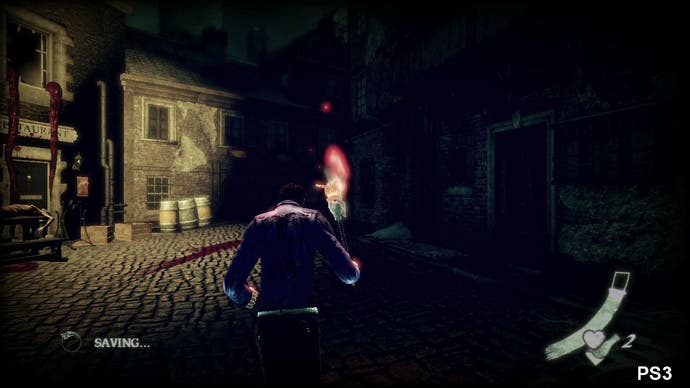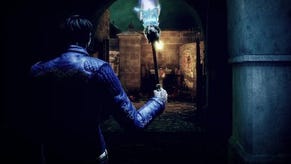Face-Off: Shadows of the Damned
Damned if you don't.
Certain areas of the game are covered in a thick veil of this dark energy, which feature some cool use of lighting and post processing effects combined for added impact. The use of light shafts in particular is especially attractive and, for the first time in an UE3 release, it has been implemented on both platforms, solidly confirming that developers are making large strides in terms of cross-platform optimisations.
Curiously, on the PS3 there also appears to be a bug in the lighting engine, which gives the impression of a slightly fuller lighting solution on 360 version of the game. These normally see some parts of the environment cast into the shadows with some harsh transitions on occasion between the lit and shaded areas.




Elsewhere, and other differences are far less pronounced. Take the way in which shadows are rendered for example. As we've seen many times before, percentage closer filtering (PCF) is used to smooth over shadow edges on the PS3, giving them a sharper appearance, while on the 360 a noisier, dithered approach is used instead. Which one is "better" largely comes down to personal preference, although in this case the use of PCF aids in providing a clearer looking game overall. The gap between the gamma output on both systems also tends to accentuate the strength of the various shadows on the 360 in some scenes, hiding environmental detail in some scenes on the odd occasion.
So far then, PS3 has the edge visually. Despite some odd lighting issues and more aggressive LODs during the cut-scenes, there are obvious benefits in other areas which have more of a visible impact on the graphical quality of the game. Better filtered textures lead to a more detailed overall presentation for one, while the lack of unsightly object pop-in during gameplay adds a greater degree of consistency to things in general. The 360's plus points - camera-based motion blur and a more consistent lighting scheme - are far more subtle in their appearance in comparison, and have less of an overall impact on the look of the game.
However, performance is just as important as image quality: more so, in fact in many cases. As we've seen most recently in Alice: Madness Returns, visual improvements don't equate to a better experience if the gameplay is adversely affected due to instabilities with regards to the frame-rate, especially in a combat-focused game.
Thankfully, this really isn't the case in Shadows of the Damned. The frame-rate isn't quite as smooth in some scenarios on the PS3, but when it counts - during the intense boss battles, or during combat with many enemies on screen in most areas - things are basically an even match. In one scene in our performance video, we see the PS3 version drop down as far as the low 20s, but this seems to be an isolated incident, and happens when quick reactions aren't expected from the player. The only nagging issue we found with the PS3 version is something of a standard problem with UE3 titles: torn frames are much more prevalent in comparison to the same game running on 360.
As for the specifics: Shadows of the Damned operates in much the same manner as the vast majority of all UE3-powered releases on Xbox 360 and PlayStation 3. The action is capped at 30FPS on both formats, but sync drops when frame-rate cannot be maintained.
In this scenario, tearing is both more frequent and heavier on the PS3 - though the Xbox 360 version clearly has some issues of its own in this regard too. However, while the analysis lays bare the differences from a technical standpoint, it isn't enough to negatively colour the experience in an overly meaningful way. Screen tearing is noticeable in places, but at the same time it isn't a massive issue, due in part to the dark nature of the game, while the odd dips in frame-rate don't tend to occur in any key action scenes where it would noticeably affect on your enjoyment of the game. In short, the game is pretty solid on both systems.
In the end, Grasshopper Manufacture has definitely created an entertaining, adult-themed survival horror turned shooter experience. The game itself isn't particularly ground-breaking: the general feeling is that we've been given a polished up revision of the formula which formed the foundations of the last two Resident Evil titles. Shadows of the Damned stands out owing to its unique visual style and some interesting gameplay ideas but it is a little inconsistent and somewhat odd, but it is well worth picking up at least for a single playthrough - especially if you've enjoyed the previous work of Shinji Mikami and Suda 51.
As for which version you should go for given the choice: both come recommended, each having its own plus points and minor issues. The additional texture clarity due to the use of better filtering on the PS3, along with improved assets streaming perhaps has more of a noticeable impact than the motion blur or the lighting advantages on 360. Performance however, favours Microsoft's console, although the differences in this respect didn't negatively affect the gameplay at all on PS3. In the final analysis, we find that the two are very close overall, but in the end the PS3 version comes across as being the slightly better of the two by a small margin.
Article by David Bierton.




